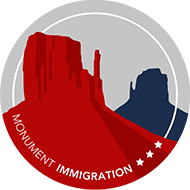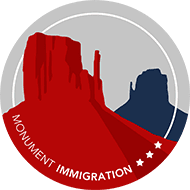Those planning a short visit to the United States may wonder if they need a visa to enter the country. There are a number of different nonimmigrant visa types, and the right one for you will depend on the nature of your visit to the country.
Here, we’ll discuss the different types of nonimmigrant visas and which one is right for you, as well as how an immigration attorney can help you prepare your application.
Different Nonimmigrant Visas
When choosing a visa, you’ll have to pick one that matches the purpose of your visit to the country. There are specific visas for different types of entry to the country, and you have to pick the one that applies to your visit.
Each visa type comes with a different name, which is a combination of a letter and a number. For example, the most common type of visa application is a B-2 visa, which applies to tourists coming to the country for a short visit.
Here are the main nonimmigrant visa types that you should know about:
- A-1
This visa applies to ambassadors and diplomats who are staying in the country, as well as their children and partners
- A-2
This visa is used for lower ranking officials of foreign governments, as well as their partners and children
- A-3
This visa is for the employees of those who are in the country on A-1 and A-2 visas, as well as their children and partners
- B-1
Used by those who are visiting the country for business purposes
- B-2
This visa is for those visiting the country for pleasure or to seek medical treatment
- C-1
Used by people who are passing through the country as they travel and who don’t plan on staying
- D-1
This visa is used by air crew members who will land in the United States as they work and will leave on the same aircraft in which they arrived
- D-2
Similar to the D-1 visa, it’s used by air crew members who arrive in the United States temporarily. However, unlike a D-1 visa, they leave on a different aircraft then the one they arrived in
- E-1
This visa is used by traders who work for a United States trading company that does a majority of its business in the visa volders home country, as well as by their children and partners
- E-2
Used by investors who work for a United States company that has a majority of its fund invested in the visa holder’s home country, as well as by their children and partners
- E-3
This visa is used only by Australian workers who visit the United States for a specific occupation. There is a small allotment of these visas (around 10,000)
- F-1
Applies to academic students or those coming to the country to study a language
- F-2
This is a separate visa category used for the children and partnerse of F-1 visa holders
- F-3
Applies to Mexican or Canadian students who commute to the United States to take classes at an academic institution
- G-1
Used by principal representatives of other governments who come to the United States for employment at an international organization, as well by their children and partners
- G-2
Used by lower ranking representatives of other governments who visit the United States to work for an international organization, as well as by their children and partners
- G-3
This visa is similar to G-1 and G-2 visas, and is used by representatives of foreign governments and their children and partners. However, the governments of G-3 visa holders are not part of an international organization
- G-4
Used by the representatives and employees of international organizations, as well as by their partners and children
- G-5
Applies to the employees of anyone who is in the country on another type of G visa, as well as to their children and partners
- H-1B
One of the most commonly used visa types by educated workers. It applies to those working at a job that requires at least a bachelor’s level education, or multiple years of job experience
- H-1C
This visa is used by nurses who plan on working for up to three years while in the United States. It only applies to those who will work in areas of the country where there is a shortage of nurses
- H-2A
Used by agricultural workers who come to the country during a shortage. The visa applies to short term work only
- H-2B
A broader visa category than H-2A, this visa applies to a wide range of different jobs where there is a current shortage of workers
- H-3
This visa applies to those who visit the United States to receive training that is not offered in their country
- H-4
This visa is used by the children and partners of any H visa holder
- I-1
Applies to members of the foreign press who are visiting the United States for assignments. It can also be used by their children and partners
- J-1
Used by those who are coming to the United States as part of a Department of State recognized exchange program, whether for education, job training, or work
- J-2
For the children and partners of J-1 visa holders
- K-1
A visa for those who are engaged to a United States citizen and who plan on coming to the country to get married
- K-2
Used by the minor children of K-2 visa holders
- K-3
A rarely used visa type, it applies to spouses of United States citizens who are still waiting for USCIS to approve their petition for a visa
- K-4
Applies to minor children of those with a K-3 visa
- L-1
Used by workers who are part of a transfer within a company. Only applies to higher level workers, such as executives and managers
- L-2
For the children and partners of those in the country on an L-1 visa
- M-1
Applies to students who are visiting the country for vocational purposes
- M-2
Used by the children and partners of those on M-1 visas
- M-3
For Mexicans and Canadians who commute to the United States to take classes at a vocational institution
- N-8
Used for the parents of certain special visa holders
- N-9
Applies to the children of those in the country on special visas
- NATO visas
These visas, numbering 1 through 7, apply to anyone working in the country as part of NATO. It can also be used by the children and partners of these workers, as well as their personal employees
- O-1
A special visa category that is used for those who show an exceptional aptitude in fields such as science, engineering, and sports
- O-2
Applies to the essential employees of those in the country on an O-1 visa
- O-3
Used by the children and partners of those holding an O-1 or O-2 visa
- P-1
A visa type that is used by athletes or performers, as well as their employees
- P-2
Applies to those who are coming to the United States to perform as part of a government sanctioned exchange
- P-3
Used by visitors to the United States who come as part of a cultural exchange
- P-4
Used by the children of partners of P visa holders
- Q-1
Used by those visiting the United States on cultural exchanges
- Q-2
A specific type of visa that is only used by those participating in the Irich Peace Process Cultural and Training Program
- Q-3
Applies to the children and partners of those in the country on a Q-1 visa
- R-1
Used by ministers or other people working for a religion recognized by the United States government
- R-2
Applies to the children and partners of those in the country on an R-1 visa
- S-5
Used by those who are giving information to a United States agency related to criminal behavior
- S-6
Used by those who are giving information to the United States government about terrorist activity
- T-1
Applies to victims of human trafficking
- T-2 and 3
Used by children and partners of those in the country on a T-1 visa
- TN
Used as trade visas for Mexicans and Canadians
- U-1
Applies to those who have suffered severe abuse in the United States and who are cooperating with a criminal investigation
- U-2 and 3
Applies to children and partners of those with a U-1 visa
Other Information On Nonimmigrant Visas
The visas listed here vary widely in terms of what they allow you to do when you enter the country. If you enter on a work visa, you likely won’t be able to take another job in the country on the same visa. Those in the country on a student visa often are not allowed to work more than a certain number of hours if they want to keep their student status.
The length of nonimmigrant visas also varies widely depending on the category. Check your visa for the exact time. Do note that the expiration date that is listed on your visa tells you the last date that you can legally enter the country. You can check the exact date that you visa expires by checking the Customs and Border Patrol website.
Contact An Immigration Attorney
If you have any more questions about which nonimmigrant visa is right for you, reach out to an experienced immigration attorney. At Monument Immigration, we have years of experience working with every type of visa application.
We can help you prepare all of the documents needed for your application within two business days. We also offer free case evaluations, where we can walk you through the visa process and answer any questions you may have.
Reach out to us by phone, or fill out our case evaluation form online.


